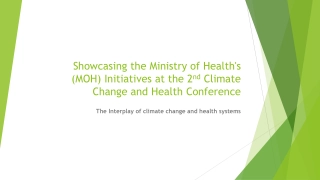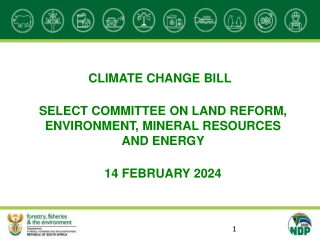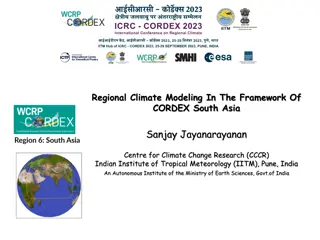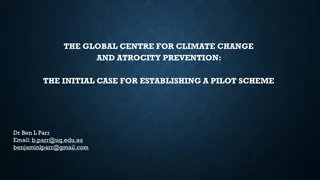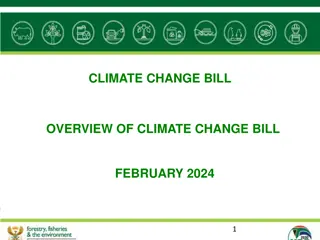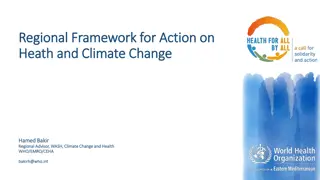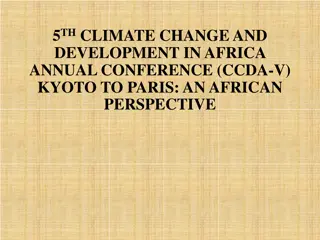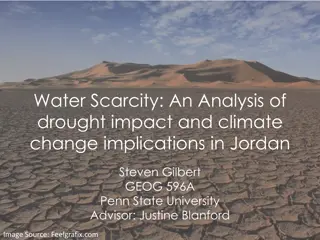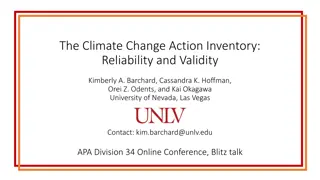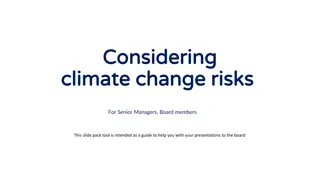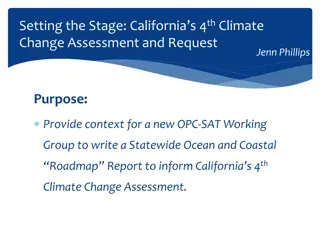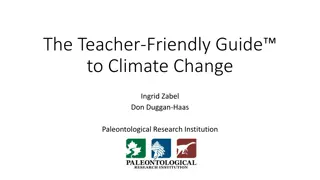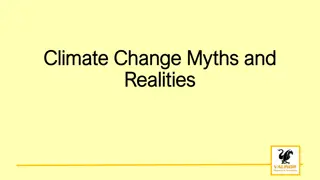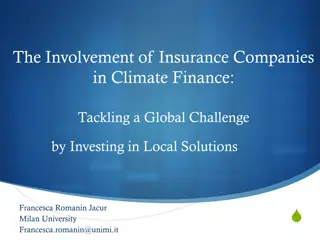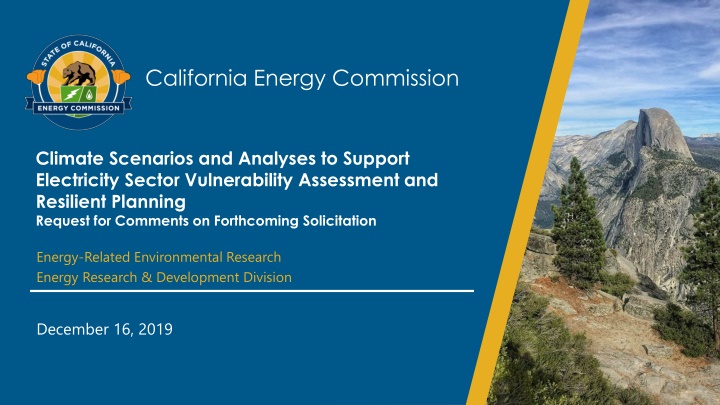
Climate Change Research & Resilient Planning in California
This excerpt discusses upcoming grant funding opportunity by the California Energy Commission for research supporting climate projections, data analytics, and resilience in the electricity sector. Input from stakeholders is sought to shape the scope of research goals and structure of the anticipated solicitation.
Download Presentation

Please find below an Image/Link to download the presentation.
The content on the website is provided AS IS for your information and personal use only. It may not be sold, licensed, or shared on other websites without obtaining consent from the author. If you encounter any issues during the download, it is possible that the publisher has removed the file from their server.
You are allowed to download the files provided on this website for personal or commercial use, subject to the condition that they are used lawfully. All files are the property of their respective owners.
The content on the website is provided AS IS for your information and personal use only. It may not be sold, licensed, or shared on other websites without obtaining consent from the author.
E N D
Presentation Transcript
California Energy Commission Research & Development California Energy Commission Climate Scenarios and Analyses to Support Electricity Sector Vulnerability Assessment and Resilient Planning Request for Comments on Forthcoming Solicitation TITLE OF PRESENTATION Name of Presenter Energy Research and Development Division Energy-Related Environmental Research Energy Research & Development Division December 16, 2019 Title of conference/meeting Location presentation was given Date of meeting
Why We Are Seeking Your Input? This Spring, we anticipate releasing a Grant Funding Opportunity that would support up to $3 M of research that supports: Development of next-generation climate projections for California s Fifth Climate Change Assessment, Delivery of data in a manner that informs energy sector planning and research through stakeholder engagement, Data analytics, and Development of a data platform. We want input from research community stakeholders, investor- owned utilities (IOUs), and other interested stakeholders to inform the scope and structure of the anticipated solicitation. 2
Workshop Agenda 1. Energy Commission staff will present: Background on anticipated solicitation funding and development. Initial ideas on the scope and structure of anticipated solicitation research goals, planned for release in the second quarter of 2020. Specific discussion questions regarding scope and structure of the proposed research. 2. Provide opportunity for open dialogue regarding the scope and structure of proposed research and presented discussion questions. Input from today s workshop plus public comments (oral and/or written comments) will help shape the grant funding opportunity. 3
EPIC Research & Development Program CEC s 2018-2020 EPIC Triennial Investment Plan includes research subtheme 7.2 Increase the Resiliency of the Electricity System to Climate Change and Extreme Weather Events. Proposed research is intended to support two initiatives associated with this subtheme: 7.2.1 Improved Understanding of Climate - and Weather-Related Risks and Resilience Options 7.2.3 Integrate Climate Readiness into Electricity System Operations, Tools, and Models (pp. 213-222) To access report: linkhttps://ww2.energy.ca.gov/research/annual_reports.html 4 4
Demands from a Changing Policy Landscape Looking forward, what do we need from climate projections, data platforms, and decision support tools? 5
Energy Utilities to Rely on Projections Provided by State CPUC s Decision on Phase 1 of Adaptation Rulemaking, issued Nov. 1, 2019*: Defines climate change adaptation for energy utilities in the state. Anchors acceptable data to California s Climate Change Assessments process, acknowledging the state s role in selecting recommended scenarios. Directs IOUs to Cal-Adapt as a source of data. Establishes criteria for acceptability of additional data or models. Also sets expectations of climate data: Climate data should provide the geographical and temporal resolution required for the research or planning at hand. (p. 54) * Decision 19-10-054, Rulemaking 18-04-019, Decision on Phase 1 Topics 1 and 2 web link: http://docs.cpuc.ca.gov/PublishedDocs/Published/G000/M319/K075/319075453.PDF 6
Executive Order Directs Resilient Investment Governor Newsom s September 20, 2019 Executive Order*: leverage state s $700 billion pension investments, transportation systems, and purchasing power to strengthen resiliency. * From press release, Sept. 20, 2019. Executive Order N-19-19. https://www.gov.ca.gov/wp-content/uploads/2019/09/9.20.19-Climate-EO-N-19-19.pdf 7
What is the High-Level Purpose of the Solicitation? Applied research funded through this solicitation will support the discussed policy needs related to resilient energy infrastructure & investment. 8
Research Goals (#1 of 5) Produce bias-corrected, downscaled climate projections for California based on the Global Circulation Model (GCM) realizations that contribute to the Coupled Model Intercomparison Project Phase 6 (CMIP6). 9
Research Goals (#2 of 5) Identify a subset of priority downscaled climate projections (priority projections henceforth) for use in the Fifth Assessment to provide a more computationally tractable set of scenarios and/or preferentially cull models based on performance (California context). Ideally, priority projections will represent a multiplicity of possible futures AND constrain uncertainty by preferential model selection, if/as possible and appropriate. In addition to the downscaled projections developed under this research grant, the pool of projections considered as possible priority projections should include peer-reviewed climate projections contributed by groups funded external to this research effort, if those projections align with the requirements (e.g., timeline, needed variables) of the Fifth Assessment. Identification of priority projections may involve collaboration with efforts funded external to this work. Draft priority projections must be presented to, and respond to input from, research teams and management involved with the Fifth Assessment. 10
Research Goals (#3 of 5) Vigorously engage energy sector stakeholders to clearly identify how climate projections can be used to foster adaptation. Stakeholders to be engaged include, but are not limited to, energy sector researchers involved with the Fifth Assessment and IOUs. Stakeholder engagement must consider various collaborative research approaches. Given the importance of stakeholder engagement, engagement must be adequately resourced. Engagement must iterate between project teams and stakeholders throughout the entire research process. 11
Research Goals (#4 of 5) Provide analytically rigorous approaches to meeting data needs elicited through stakeholder engagement based on the projections developed by this research grant as well as other peer-reviewed downscaled climate projections that align with the requirements of the Fifth Assessment. It is expected that the research team will provide: Quasi-probabilistic interpretations of climate projections, where needed and appropriate, and/or provide some other approach to facilitate decision-making under uncertainty. Indicators of uncertainty (qualitative and/or quantitative). 12
Research Goals (#5 of 5) Provide an interactive, publicly available, open-source data platform that facilitates data download, supports analytical approaches developed in response to stakeholder needs, and provides interactive visualizations of climate data. Data platform development will be driven by needs identified through stakeholder engagement and by analytics developed by climate scientists. Data platform developers funded under this grant will have the option of building on architecture and design associated with the current version of Cal-Adapt, or building a new architecture. Development of visualizations should be informed by energy stakeholder needs through engage- ment and should consider how tools associated with prior generations of Cal-Adapt were used. Development of visualizations will also be closely coordinated with stakeholder engagement efforts led by Strategic Growth Council (SGC) and the Governor s Office of Planning and Research (OPR) to elicit data-related needs of local governments, tribal communities, and non-energy researchers. 13
Potential Research Organizational Structure The proposed research will be organized as either one or two distinct, funded efforts. In either case, funded project[s] will require an overarching, skilled, well- resourced management team to ensure coordination between the different aspects of the proposed research. Potential organizational structure for research if funded as a single funded effort, delivering: Downscaled climate projections; A subset of priority projections recommended for use in the Fifth Assessment; Stakeholder engagement to clearly identify how climate projections can be used to support energy- related research and adaptation; Analytically rigorous approaches to meeting data needs elicited through stakeholder engagement based on the projections developed by this research grant AS WELL AS other peer-reviewed downscaled climate projections that align with the requirements of the Fifth Assessment; and An interactive, publicly available data platform that will coordinate with Cal-Adapt.org to provide access to Fifth Assessment scenarios and analytics. 14
Potential Research Organizational Structure The proposed research will be organized as either one or two distinct, funded efforts. In either case, funded project[s] will require an overarching, skilled, well- resourced management team to ensure coordination between the different aspects of the proposed research. Potential organizational structure for research if funded as two distinct funded efforts, delivering: Downscaled climate projections; A subset of priority projections recommended for use in the Fifth Assessment; Stakeholder engagement to clearly identify how climate projections can be used to support energy- related research and adaptation; Analytically rigorous approaches to meeting data needs elicited through stakeholder engagement based on the projections developed by this research grant AS WELL AS other peer-reviewed downscaled climate projections that align with the requirements of the Fifth Assessment; and An interactive, publicly available data platform that will coordinate with Cal-Adapt.org to provide access to Fifth Assessment scenarios and analytics. 15
Potential Research Organizational Structure The proposed research will be organized as either one or two distinct, funded efforts. In either case, funded project[s] will require an overarching, skilled, well- resourced management team to ensure coordination between the different aspects of the proposed research. Potential organizational structure for research if funded as two distinct funded efforts, delivering: Downscaled climate projections; A subset of priority projections recommended for use in the Fifth Assessment; IDENTIFICATION OF PRIORITY PROJECTIONS GRANT DEVELOPMENT OF CLIMATE PROJECTIONS FOR CALIFORNIA AND Stakeholder engagement to clearly identify how climate projections can be used to support energy- related research and adaptation; Analytically rigorous approaches to meeting data needs elicited through stakeholder engagement based on the projections developed by this research grant AS WELL AS other peer-reviewed downscaled climate projections that align with the requirements of the Fifth Assessment; and An interactive, publicly available data platform that will coordinate with Cal-Adapt.org to provide access to Fifth Assessment scenarios and analytics. ENGAGEMENT, ANALYTICS AND DATA PLATFORM GRANT 16
Discussion Questions Organizational/Structure Questions Scope Questions Additional Questions for Consideration 17
Discussion Questions (continued) Organizational/Structure Questions 1. What factors should be considered in the decision of whether to fund one single effort or two smaller efforts? 2. How can we explicitly incentivize the role of strong project management to ensure strong internal coordination (and coordination between grants, if two grants are funded) and successful design, application, and stakeholder adoption of data products? 18
Discussion Questions (continued) Scope Questions 3. EPIC has funded an ongoing project (EPC-16-063) to develop hybrid downscaling methodologies, but the current GFO does not require that methodology to be used for the Fifth Assessment. What criteria or metrics should the GFO identify for evaluating applicants proposed downscaling methods? 4. Ideally, the project(s) from this GFO will generate priority projections that represent a multiplicity of possible futures and constrain uncertainty by preferential model selection. We would like to open the floor for discussion of this goal and considerations that the GFO language should reflect. 19
Discussion Questions (continued) Scope Questions (continued) 5. What ongoing work to cull models contributing to CMIP6 for California should the proposed research be coordinating with? How should the proposed grant be scoped to leverage and coordinate existing or planned efforts? 6. As California increasingly strives to integrate projected climate change into infrastructure design and planning, understanding the likelihood of possible outcomes and uncertainty of projections is increasingly important. We would like to open the floor for discussion of considerations that the GFO language should reflect regarding quasi-probabilistic interpretation of projections and indicators of uncertainty. 20
Discussion Questions (continued) Additional Questions for Consideration 7. Practitioners of climate change risk management may preferentially use projections that perform well in the historical period for their area of interest, based on available observations. a. Should the Fifth Assessment require bias correction to help meet this desire? b. How should the desire for historically validated projections play in to the development of priority projections and/or guidance for usage of projections? 21
Discussion Questions (continued) Additional Questions for Consideration (continued) 8. Climate change vulnerability assessment and risk management can be approached through a top-down, scenario-driven framework as well as through a bottom-up, robust decision-making framework. Ideally, the Fifth Assessment will include both top-down and bottom-up approaches that are harmonized so that different studies results can be integrated and used to deepen our understanding of risks and resilience options. a. Are there considerations regarding a desire to harmonize and integrate top-down and bottom-up approaches that should be articulated in the GFO language? 22
Thank You! Please submit your written comments by 5:00 p.m. Dec 30, 2019 Submit electronically through the Energy Commission s Research Idea Exchange docket here: https://efiling.energy.ca.gov/Ecomment/Ecomment.aspx?docketnumber=19-ERDD-01 Or by email to the Docket Unit at: docket@energy.ca.gov Or by paper copy to the Docket Unit: California Energy Commission || Docket Unit, MS-4 || Re: Docket No. 19-ERDD-01 || 1516 Ninth Street || Sacramento, CA 95814-5512 Visit: https://ww2.energy.ca.gov/research/notices/#12162019 to view the workshop notice, presentation, and WebEx Recording (forthcoming). 23

